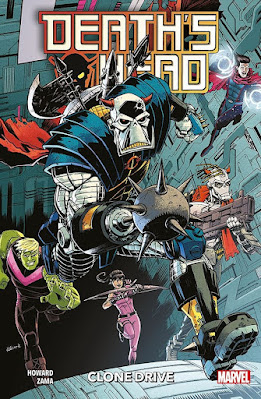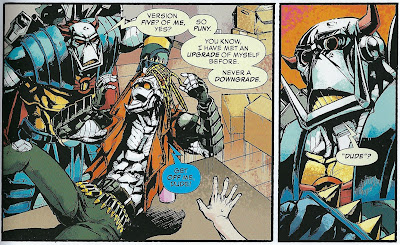Mistress of Chaos: Collected comic strips from the pages of Doctor Who Magazine
by Scott Gray, John Ross, Mike Collins, and David A Roach
 |
|
Collection published: 2020 Contents originally published: 2018-20 Acquired: January 2021 Read: March 2023 |
The Warmonger, from Doctor Who Magazine #531-34 (Dec. 2018–Feb. 2019)
story by Scott Gray, art by John Ross, colours by James Offredi, lettering by Roger Langridge
So the caveat to everything I am going to discuss here is that I am not really a fan of the Jodie Whittaker era on screen, as the writing and direction make what are—to me at least—frequently baffling choices that eliminate the possibility of drama and character development. I struggled with Titan's Thirteenth Doctor comics, which I felt emulated the parent show very well... by being sort of boring and aimless and not knowing how to handle having three companions.
Which is to say, that I like what Scott Gray does here and in the volume's subsequent stories, which is tell the same kind of entertaining strip stories he always tells, just with a new set of characters. I always liked the potential of the thirteenth Doctor, Yaz, Graham, and Ryan, but the show rarely delivered on it. Gray, though, is always good at incorporating strong character beats into his writing, and as ever, we get that here, as the TARDIS delivers the four of them into a warzone. Yaz is strong-willed and idealistic; there's a great scene where she stares down some looters. Graham and Ryan are well-meaning but a bit comic; they get some fun material here when they're separate from the Doctor, especially when Ryan flirts with a robot news reporter. (Gray is good at splitting the fam up into different combinations across these stories.) The Doctor is impish, impulsive, steely, and radically compassionate. There was this idea nascent in early thirteenth Doctor stuff that she would be compassionate to the point of being dangerous but I'm not sure it always worked on screen; I actually reckon that aside from Gray, the two stories to capture the thirteenth Doctor best are Paul Cornell's lockdown tales "The Shadow Passes" and "The Shadow in the Mirror." In the latter, the Doctor extends a very dangerous but ultimately successful forgiveness, and we see something like that in her solution to this story's crisis.
 |
| from Doctor Who Magazine #533 |
The place where this story clearly diverges from its screen counterpart is in its use of a returning villain. While series 11 very much eschewed any returning elements at all, this brings back Berakka Dogbolter. While she only appeared for the first time back in The Stockbridge Showdown in #500, she's the daughter of long-running foe Josiah W. Dogbolter, taking us all the way back to DWM's 1980s "golden age." It's a nice move, I think: the Doctor may be different, the set-up may be different, the screen version may have a very different style, but the reader of the DWM comic knows that it's still the same story that began with The Iron Legion.
Of the new series Doctor, three were introduced by Mike Collins and a fourth by Martin Geraghty, both of whom have a very realistic style. Here, we get the dynamic John Ross on art, and he very much nails it: his likenesses are less direct but also very strong. He juggles a lot of elements in this story, and the reader is kept on top of all of them. I've liked his stuff all long, but his material in this volume is surely him at the top of his game.
So yeah, like a lot of Scott Gray's stories, there's not something I can point to that makes it a work of genius, but it is a well-executed piece of strong Doctor Who. Good characterization, neat worldbuilding, dynamic ideas.
 |
| from Doctor Who Magazine #535 |
story by Scott Gray, pencil art by Mike Collins, inks by David A Roach, colours by James Offredi, lettering by Roger Langridge
This is a fun historical story about the Doctor and fam crashing a gathering of astronomers and such, focusing on Tycho Brahe and Johannes Kepler. I don't have a lot to say about it that I didn't about the previous story, but again, Gray does a great job of putting together an interesting story with good reversals that splits up the regulars to strong effect. Yaz gets a good bit, where she pretends to steal someone's soul with her phone, but really they all across strongly.
Mike Collins is always good, but after reading this I kind of wondered if they didn't give him Jodie's debut because his likenesses for women are not quite as good as his ones for me (he always kind of struggled with Amy in particular), and now the lead character is a woman.
 |
| from Doctor Who Magazine #540 |
story & art by Scott Gray, colours by James Offredi, lettering by Roger Langridge
Scott Gray takes on his first multi-part story as an artist. The Mobox have appeared in a few previous DWM stories, most notably Ophidius and Uroboros, but they've never looked better than they look here, as somewhat Kirbyesque creations... but one of their strengths is they're not monsters, they're people; I came to really like R'Takk, the grumpy but well-meaning Mobox captain the fam encounters. The Kirby tone for all tech here really works; honestly, more Doctor Who artists should do this, because it's a good fit for the sensibilities of Doctor Who.
There's a great cliffhanger where it looks like the Mobox disintegrated Graham and Yaz, but long-time DWM readers will remember that Mobox store what they de-materialize inside them and can bring it back. When I first read this story in DWM in 2019, I did not remember that fact from the earlier Mobox stories almost two decades prior, but this time I did (having read the relevant stories less than a year ago), so nicely done, Scott. As always, each character gets a moment to shine, and Gray puts them in a different combination every time.
 |
| from Doctor Who Magazine #544 |
story by Scott Gray, art by John Ross, colours by James Offredi, lettering by Roger Langridge
The finale to this set of stories brings back Berakka from The Warmonger and the Herald of Madness from, well, you know... and finally brings us to the planet Segonus that gives this series of posts its alliterative title! The Doctor discovers that the Herald of Madness wasn't a reflection of her... but actually her.Like I said above, this set-up for Doctor Who never worked for me on screen, but Gray reveals the potential that was there all along and really makes it sing.
Again, filled with strong moments; I like Gray's steely thirteenth Doctor, who goes after Berakka when she realizes Berakka is trying to ruin her reputation. There are creepy baddies and a good role for Graham and excellent art from John Ross once more. Clever stuff as always, and James Offredi is on fire here as a colourist. Of course, the realms of logic and chaos are distinguished from each other, but they're also very distinct from the real world too.
My main issue is that "evil Doctor" stories are always tricky: the bad Doctor has to convince as the Doctor, and this doesn't always happen. Gray gets closer than most, but one never really feels like the chaos Doctor and the logic Doctor are possible future Doctors. The idea that they reflect different key aspects of the Doctor's personality comes through better in the commentary than in the actual story, where it feels more abstract. I did really like the resolution, though, and the story's closing moments—a montage of people highlighting the good the Doctor does, complete with Sharon cameo—is a fitting one for this particular Doctor, who is often positioned as a source of hope in the darkness.
Stray Observations:
- If you're the kind of person who cares about these things, note that The Warmonger, The Power of the Mobox, and Mistress of Chaos all take place during the same time period, which must be what Ahistory calls "the mazuma era," around the time of Dogbolter and Death's Head in the 82nd century. I don't think there was ever any kind of even loose dating given for Ophidius and Uroboros, but the presence of the Mobox empire here would seem to place them in the same era as well.
- Surely it ought to have been The Power of the Mobox!, right?
- Three different versions of Jodie Whittaker in a series finale? Whatever the tv show can come up with, Scott Gray always gets there first!
- Three of the four stories feature a mysterious "Mother G," who knows the TARDIS; she tells the Doctor what the "G" stands for in Mistress of Chaos, but we don't get to hear that answer ourselves... and the Doctor doesn't believe it. Well, I look forward to seeing where Scott Gray goes with this in what will surely be a key thread to his long run on the thirteenth Doctor's comics for the next two-and-a-half years!
- "JUST A TRACER" WATCH: David A Roach Appreciation Society triumphant! That's right, he finally garners cover credit for a volume where he is a "mere" inker. We did it!
* Well, kind of.
This post is the forty-seventh in a series about the Doctor Who Magazine comic strip and Marvel UK. The next installment covers issues #215–18, 223–27, and 235–54 of Transformers UK. Previous installments are listed below:
- The Iron Legion
- Dragon's Claw
- The Transformers Classics UK, Volume One
- The Tides of Time
- The Transformers Classics UK, Volume Two
- Voyager
- The Transformers Classics UK, Volume Three
- The World Shapers
- The Transformers Classics UK, Volume Four
- The Age of Chaos
- The Transformers Classics UK, Volume Five
- A Cold Day in Hell!
- Death's Head: Freelance Peacekeeping Agent (part 1)
- Nemesis of the Daleks
- Death's Head: Freelance Peacekeeping Agent (part 2)
- The Good Soldier
- The Incomplete Death's Head
- Evening's Empire
- The Daleks
- Emperor of the Daleks
- The Sleeze Brothers File
- The Age of Chaos
- Land of the Blind
- Ground Zero
- End Game
- The Glorious Dead
- Oblivion
- Transformers: Time Wars and Other Stories
- The Flood
- The Cruel Sea
- The Betrothal of Sontar
- The Widow's Curse
- The Crimson Hand
- The Child of Time
- The Chains of Olympus
- Hunters of the Burning Stone
- The Blood of Azrael
- The Eye of Torment
- The Highgate Horror
- Doorway to Hell
- Daleks: The Ultimate Comic Strip Collection, Volume 1
- The Phantom Piper
- Daleks: The Ultimate Comic Strip Collection, Volume 2
- The Clockwise War
- Death's Head: Clone Drive / Revolutionary War
- Skywatch-7



















